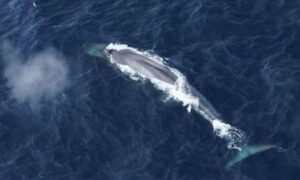
Centuries of industrial whaling left only a few hundred Antarctic blue whales alive, making it almost impossible to find them in the wild.
Now new research suggests the population may be recovering. Australian scientists and international colleagues spent two decades listening for their distinctive songs and calls, and found the whales – the largest animals ever to have lived – swimming across the Southern Ocean with growing regularity.
Analysis of thousands of hours of audio, collected with underwater microphones and secondhand military-issued submarine listening devices, suggests whale numbers are stable or on the rise, according to Australian Antarctic Division senior research scientist Brian Miller.
“When you look back to before this work was started by the AAD, we really just had so few encounters with these animals – and now we can produce them on demand,” Miller said.
Researchers have spent hours listening for repeating songs about 20 seconds long, termed Z calls, along with shorter, higher-pitched D calls, in an effort to track and study the critically endangered species.
“We think the message is: ‘I’m a blue whale, I’m here,’” Miller said.
“If you think about … us almost wiping them out, and extinction, then it becomes more poignant to think about them saying, ‘I’m still here, here I am.’”
